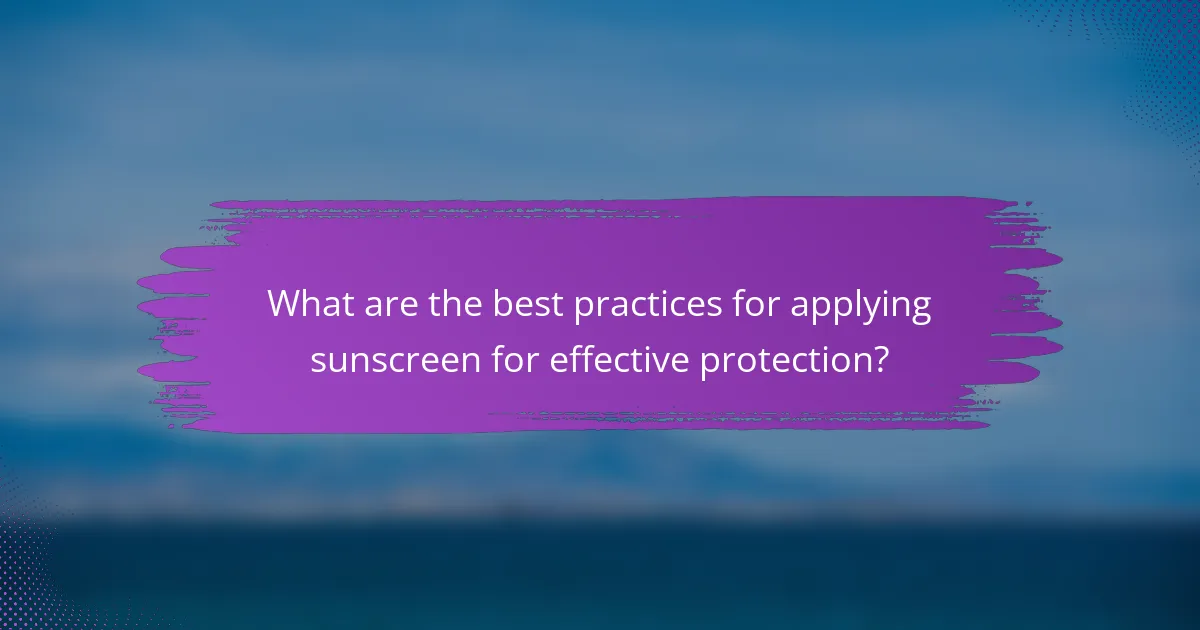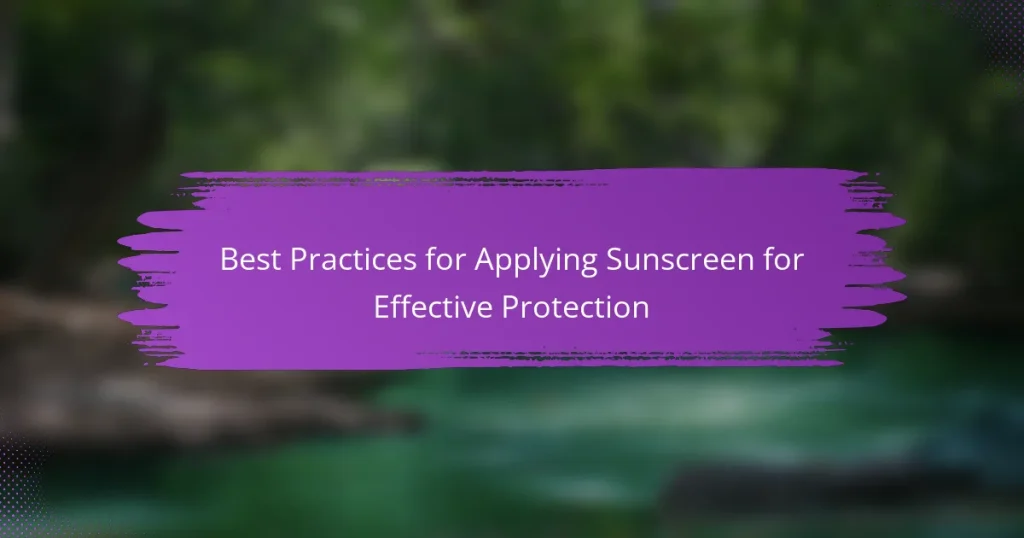The article focuses on best practices for applying sunscreen to ensure effective protection against harmful UV rays. It emphasizes the importance of using a broad-spectrum sunscreen with a minimum SPF of 30 and applying it generously to all exposed skin, approximately one ounce for full body coverage. Key recommendations include applying sunscreen 15 to 30 minutes before sun exposure, reapplying every two hours, and using water-resistant formulas when swimming or sweating. Additionally, it highlights the necessity of covering often-overlooked areas such as the ears, feet, and back of the neck to minimize the risk of sunburn and long-term skin damage.

What are the best practices for applying sunscreen for effective protection?
Apply sunscreen generously to all exposed skin. Use about one ounce, equivalent to a shot glass, for full body coverage. Apply it 15 to 30 minutes before sun exposure to allow absorption. Reapply every two hours, or immediately after swimming or sweating. Choose a broad-spectrum sunscreen with at least SPF 30 for effective protection against UVA and UVB rays. Ensure to cover often-missed areas like ears, feet, and the back of the neck. Use water-resistant formulas if swimming or sweating. Following these practices can significantly reduce the risk of sunburn and long-term skin damage.
Why is it important to apply sunscreen correctly?
Applying sunscreen correctly is crucial for effective skin protection. Proper application ensures an even layer that maximizes UV coverage. Incorrect application can leave skin vulnerable to harmful UV rays. Research indicates that 90% of skin cancers are linked to UV exposure. According to the Skin Cancer Foundation, inadequate sunscreen use increases the risk of sunburn and long-term skin damage. Applying the right amount, typically about an ounce for full body coverage, is essential. Additionally, reapplying every two hours maintains protection, especially after swimming or sweating. Following these guidelines significantly reduces the risk of skin-related health issues.
What are the common mistakes people make when applying sunscreen?
People commonly make several mistakes when applying sunscreen. One mistake is not using enough product. Studies suggest that most individuals apply only 25% to 50% of the recommended amount. Another mistake is not reapplying sunscreen frequently enough. Experts recommend reapplication every two hours, especially after swimming or sweating. Additionally, many people forget to cover all exposed areas. This can lead to uneven protection and sunburn in missed spots. Some individuals also apply sunscreen too late, missing the recommended application time of 15 to 30 minutes before sun exposure. Lastly, relying solely on makeup with SPF is a mistake. Makeup often does not provide sufficient coverage for effective protection.
How does improper application affect sunscreen efficacy?
Improper application significantly reduces sunscreen efficacy. When sunscreen is not applied evenly, certain skin areas remain unprotected. Insufficient amounts of sunscreen lead to inadequate coverage. Studies show that applying less than the recommended amount can decrease protection by up to 50%. Additionally, missing spots can result in sunburn and skin damage. Rubbing sunscreen in too quickly may also limit absorption. For maximum effectiveness, sunscreen should be applied generously and uniformly. Reapplication is essential, especially after sweating or swimming.
What factors should be considered when choosing sunscreen?
When choosing sunscreen, consider the SPF rating, which indicates the level of protection against UVB rays. An SPF of 30 or higher is recommended for effective protection. Broad-spectrum protection is essential, as it guards against both UVA and UVB rays. The formulation type matters; options include lotions, gels, sprays, and sticks. Choose a water-resistant formula if engaging in swimming or sweating. Skin type is also a factor; those with sensitive skin should opt for mineral-based sunscreens with zinc oxide or titanium dioxide. Ingredients should be checked for potential allergens or irritants. Lastly, expiration dates are crucial; expired sunscreen may not provide adequate protection.
What are the different types of sunscreen available?
There are several types of sunscreen available. The main categories include chemical, physical, and hybrid sunscreens. Chemical sunscreens absorb UV radiation through their chemical ingredients. They often contain compounds like avobenzone or octisalate. Physical sunscreens, also known as mineral sunscreens, contain active mineral ingredients such as zinc oxide or titanium dioxide. These ingredients sit on the skin’s surface and reflect UV rays. Hybrid sunscreens combine both chemical and physical ingredients for broader protection. Each type offers varying levels of protection and skin compatibility.
How do SPF ratings influence sunscreen selection?
SPF ratings significantly influence sunscreen selection by indicating the level of UVB protection offered. Higher SPF values suggest greater protection against sunburn and skin damage. For example, an SPF of 30 blocks about 97% of UVB rays, while SPF 50 blocks approximately 98%. Consumers often choose products based on these ratings to ensure adequate protection during sun exposure. Research shows that many people underestimate the importance of SPF, leading to inadequate protection. Thus, understanding SPF ratings helps consumers make informed decisions about sunscreen effectiveness.
What is the proper technique for applying sunscreen?
The proper technique for applying sunscreen involves several key steps. First, choose a broad-spectrum sunscreen with at least SPF 30. Apply it generously to all exposed skin. Use about one ounce, or a shot glass full, for full body coverage. Apply sunscreen 15 to 30 minutes before sun exposure to allow it to absorb. Reapply every two hours, or more often if swimming or sweating. Make sure to cover hard-to-reach areas, such as the back of the neck and ears. Don’t forget to apply sunscreen to your lips and around your eyes. According to the American Academy of Dermatology, proper application significantly reduces the risk of skin cancer and premature aging.
How much sunscreen should be applied for full coverage?
Apply one ounce of sunscreen for full coverage. This amount is roughly equivalent to a shot glass or the size of a palm. It is recommended to cover all exposed skin thoroughly. Areas often missed include ears, neck, and the tops of feet. Reapplication is necessary every two hours, or immediately after swimming or sweating. This ensures optimal protection from UV rays. The Skin Cancer Foundation supports this guideline for effective sun protection.
What is the recommended order of application with other skincare products?
The recommended order of application for skincare products is to start with the thinnest texture and move to the thickest. Begin with a cleanser to remove impurities. Follow with a toner to balance the skin’s pH. Next, apply serums which are typically lightweight and packed with active ingredients. After serums, use any treatment products, such as acne or anti-aging treatments. Then, apply moisturizers to hydrate the skin. Finally, finish with sunscreen to protect against UV damage. This layering technique ensures optimal absorption and efficacy of each product.
How often should sunscreen be reapplied for maximum effectiveness?
Sunscreen should be reapplied every two hours for maximum effectiveness. This recommendation is supported by dermatologists and health organizations. If swimming or sweating, reapplication should occur more frequently, approximately every 80 minutes. The effectiveness of sunscreen diminishes over time due to factors like absorption and wear. Regular reapplication ensures consistent protection against harmful UV rays. Studies indicate that proper reapplication significantly reduces the risk of skin damage and sunburn.
What activities necessitate more frequent reapplication?
Activities that necessitate more frequent reapplication of sunscreen include swimming, sweating, and towel drying. Swimming can wash away sunscreen, reducing its effectiveness. Sweating can also dilute sunscreen, especially during intense physical activity. Towel drying removes sunscreen from the skin, necessitating reapplication afterward. Experts recommend reapplying sunscreen every two hours, or more frequently if engaging in these activities. The American Academy of Dermatology advises applying sunscreen immediately after swimming or sweating for optimal protection.
How does water exposure impact sunscreen effectiveness?
Water exposure significantly reduces sunscreen effectiveness. When sunscreen is exposed to water, it can wash away or dilute, leading to decreased protection. Water-resistant sunscreens are designed to maintain effectiveness for a specified duration while swimming or sweating. For example, a water-resistant sunscreen may remain effective for up to 80 minutes in water. However, reapplication is necessary after swimming or towel drying to ensure continued protection. Studies indicate that proper application and reapplication are crucial for maintaining sunscreen efficacy, especially after water exposure.
What additional tips can enhance sunscreen application?
Apply sunscreen generously to all exposed skin. Use at least one ounce for full-body coverage. Reapply every two hours or immediately after swimming or sweating. Choose a broad-spectrum sunscreen with at least SPF 30. Apply sunscreen 15 minutes before sun exposure for optimal absorption. Don’t forget areas like ears, feet, and scalp. Use water-resistant formulas for prolonged outdoor activities. Check expiration dates to ensure effectiveness.
How can one ensure even coverage across all skin areas?
To ensure even coverage across all skin areas, apply sunscreen generously and evenly. Use about one ounce, or a shot glass full, for full body coverage. Start with the face, applying in upward circular motions. Move to the neck and ears, ensuring no areas are missed. Apply to the arms, starting from the shoulders and working down to the wrists. For the legs, cover from the thighs down to the ankles. Don’t forget to include areas like the tops of feet and the back of the hands. Reapply every two hours, or more often if swimming or sweating. Research shows that proper application significantly reduces the risk of sunburn and skin damage.
What are the best practices for applying sunscreen on children?
Apply sunscreen to children generously and evenly. Use a broad-spectrum sunscreen with at least SPF 30. Apply it 15 to 30 minutes before sun exposure. Reapply every two hours, or more often if swimming or sweating. Use enough sunscreen; about one ounce is recommended for full body coverage. Don’t forget areas like ears, feet, and behind the knees. For children under six months, avoid direct sun exposure and consult a pediatrician for sunscreen use. These practices help prevent sunburn and long-term skin damage.
What common troubleshooting tips should be considered when using sunscreen?
Ensure proper application of sunscreen by using enough product. Apply at least one ounce for full body coverage. Reapply every two hours, or more frequently if swimming or sweating. Check the expiration date on the sunscreen bottle. Expired products may not provide effective protection. Store sunscreen in a cool, dry place to maintain its efficacy. Avoid using sunscreen on broken or irritated skin, as it may cause further irritation. If experiencing skin reactions, discontinue use immediately and consult a healthcare professional. Use broad-spectrum sunscreen to protect against both UVA and UVB rays for comprehensive coverage.
How can one address issues with sunscreen consistency or irritation?
To address issues with sunscreen consistency or irritation, one can choose a sunscreen formulated for sensitive skin. These products often contain fewer irritants and are less likely to cause reactions. Additionally, applying a moisturizer before sunscreen can create a smoother base. This can help improve the application and reduce irritation.
Using a sunscreen with a lighter texture may also help. Gel or spray formulations can feel less heavy on the skin. If irritation occurs, switching to a mineral sunscreen may be beneficial. Mineral sunscreens typically contain zinc oxide or titanium dioxide, which are gentler on the skin.
Patch testing a new sunscreen on a small skin area before full application can prevent widespread irritation. Lastly, if irritation persists, consulting a dermatologist is advisable. They can recommend suitable products based on individual skin types and concerns.
What should be done if sunscreen runs or washes off during activities?
Reapply sunscreen immediately if it runs or washes off during activities. This ensures continuous protection against UV rays. Use a water-resistant sunscreen for activities involving sweat or water. Apply a generous amount to all exposed skin areas. Wait for about 15 minutes before resuming activities to allow absorption. Reapply every two hours or more frequently if swimming or sweating heavily. Studies indicate that reapplication significantly enhances UV protection. Following these steps helps maintain effective sun protection during outdoor activities.
The main entity of this article is sunscreen, specifically focusing on best practices for its application to ensure effective protection against harmful UV rays. Key topics include the importance of applying the correct amount of sunscreen, recommended SPF levels, and techniques for even coverage across all skin areas. The article also addresses common mistakes in sunscreen application, the impact of water exposure, and factors to consider when selecting a sunscreen type. Additionally, it provides guidelines for reapplication frequency and tips for enhancing sunscreen effectiveness, particularly for children and individuals with sensitive skin.


